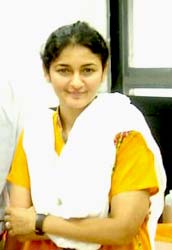
More than 200 days into covering the Indian animation industry and the thought that one knows everything about it begins to creep in. The smugness, however is shortlived.
A fine friday afternoon, while conversing with IDC animation faculty Shilpa Ranade and the animation students at IDC, one is greeted with some terms alien to Indian animation.
“There is hardly any personal animation in India” is how Shilpa and her students greet you.
Personal animation! (Is that a fancy concept of the celebrated grey matter at IIT? one wonders) swallowing pride, one sheepishly has to ask,
What is personal animation?
“Isn’t art supposed to be a means of expression for an individual?” questions Shilpa.
Yes of course it is, but what does that have to do with animation? one retorts.
“Isn’t animation an art form?” says Shilpa.
Oooooh…. Oh Yes, Oh yes of course animation is art, I’ve heard that in all the seminars, speeches and debates that I have covered out here. But what does drawing, sketching, texturing and narrating according to other people’s concepts and instructions have to do with personal art?
“Exactly!”
That’s Professor Shilpa for you and in the following excerpts from a conversation with her, there’s a lot of mention about personal animation and more.
Professor Shilpa Ranade is the animation faculty at IDC. Housed within the sprawling IIT campus in Powai, Mumbai, the IDC is one of the country’s premiere design institutes. The institute has 2 courses, industrial design and visual communication. Animation is an elective subject and part of the visual communication course at IDC.
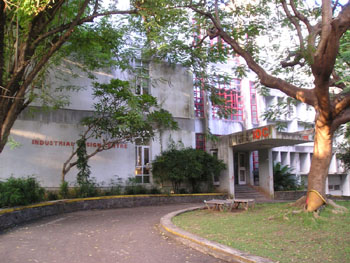
Could you first enlighten us about the courses at IDC and where does animation fit in?
IDC has 2 post graduate courses, the first one being industrial design and the other being visual communication. Animation is an elective within the visual communication course.
How many students do you have? How does one seek admission to the IDC?
We have a common entrance exam for design for which about 1400 applicants apply every year. Out of those 1400, approx. 100 people are short listed. These 100 are put through tests where their overall aptitude, design skills and problem solving abilities are observed. They are asked to address issues like redesigning a map or maybe doing a website for railway booking or a route map for a bus. We observe their design sensibilities in tackling diverse subjects which are common indigenous design problems.
Following that we have a portfolio submission, and a personal interview. While selecting students we look for people with strengths that that set them apart. We have about 35 students per batch at IDC and around half have been awarded teaching assistantships.
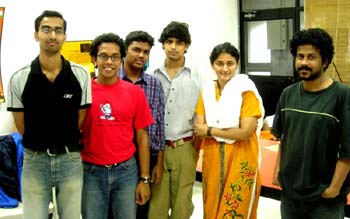
What about the animation course?
How many students have opted for animation this year?
7 students opted for animation this year and that is a big number for IDC.
As I earlier mentioned, animation is an elective within visual communication. The course is still in evolution, it’s growing, it is not yet exactly what we want it to be.
3 years ago when I, (Shilpa is an IDC alumnus) was here to do a workshop on animation. A lot of students showed interest in the medium and IDC decided to respond by including an animation elective.
I became the first animation person to join as faculty and am responsible for the course here including the lab and the curriculum development. Even before I joined, there were students who were doing interesting animation projects. but there wasn’t an animation course then, they did projects using animation as a medium they had to explore and figure out for themselves.

Students here are from different backgrounds like engineering, architecture, fine arts etc. Each one’s approach to design is distinct. When I joined, we began by doing some basic excercises in animation and getting more people interested in and excited about the medium.
The students hadn’t seen much animation apart from Disney or Tom and Jerry shorts, animated serials, and other mainstream feature length animation. The exposure level to animation in India is minimal and limited. We showed them lots of films and exposed them to different kinds of animation, not just mainstream animation but different styles, different techniques, 60s’ animation, contemporary animation.
The students here don’t get into a mould and are not taught a style, rather they drive the medium as they choose to, bringing to it their design sensibilities. Basically what we expect out of them is personal animation and not classical animation. Of course the issues they address are pertinent to our culture.
They might want to do 3D, puppet, flash animation , 2D, anything, the animation sensibility stays the same across techniques. We hope that all the people who go out of IDC will be able to drive other people as directors and pre prod people, involved in creating original content. Their work is supposed to demonstrate that it can happen.
Right now the course is in flux, gradually we would like to have a full time animation course and it is definitely in the pipeline.
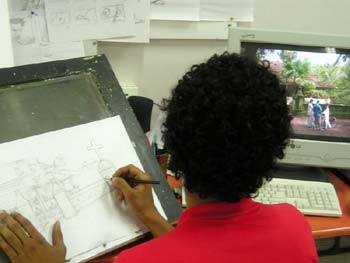
What sort of a dedicated course are you planning?
Masters in Design with animation as specialization. It would introduce all classical principles but these can be interpreted by individuals as they feel. One doesn’t need to rigidly stick to the rules as prescribed. What matters is that the students should be aware of the principles, and should be able to apply the same to their chosen styles.
We are trying to talk to a lot of people including international colleges. We are looking at different models, there is a range of them, like the Royal College of Art UK, model, where there is not much structure and the students have a lot of space to grow and to evolve their individual styles and technique.
Then there are other courses which are undergraduate courses where everything is taught and things are very structured. We are trying to do a balanced combination of the 2, because our entry level here wouldn’t be people who have graduated out of animation, there would be people who have graduated from any other discipline maybe even from engineering, people who haven’t even had an art background at times. We are trying to cater to that in our curriculum.
Another thing that I’d like to add here would be that we are always trying to depart from the norm of what animation is perceived to be in terms of both style and content.
What is the course currently like?
Even currently, there’s a lot of research involved in doing projects here. There are many impressive projects that the students have come up with. One interesting film made here is the story of the various stages of development of the foetus. The story is told from the foetus’ point of view.
We look at issues that one normally wouldn’t think of animating, like for instance a student made a film on anger management and it was impressive.
The course is not rigid or restrictive, it grows organically, it is a PG course, students have to submit research papers and reports on the projects that they are doing.
The industry is growing in a certain manner, we have a lot of backend work happening here but we don’t have any front end work that, I feel is a pity.
“We need thinking animators and unless there is enough exposure, whatever percentage of good work we have will also not be valued”
What are your views on Indian animation?
There is hardly any space for personal animation here. One needs a lot of funding and some very strong support, we haven’t had that and so there isn’t a particular animation culture in our country. Whatever little support that’s available, is from the films division and CFSI , who have their own agendas. We need a much more open attitude for animation to evolve as a medium.
You need to have a worldview, you need to experiment with the medium, you need to push the medium. We always try to fit in somehow with what the west requires, There is no platform for personal animation, makers of art animation, or animation that addresses needs of communication other than entertainment.
We have very limited notions about animation. Like it has to be funny or it has to be for kids, we need to break away from that – we need to enlarge the scope of the medium.
We need to fund animation film making, also these films should be shown beyond the festival circuits. In the UK you have organizations like the arts council, you get wonderful support to make all kinds of animation. There is a big mainstream audience even for these films. They are shown on television which is a mass medium , the government has to set aside a telecast time for these films, not everything can be valued in monetary terms.People want to see good films, Channel 4 has an hour set aside every week to showcase interesting animation.
We can draw upon our rich and varied culture of storytelling and images to make animation that is relevant and pertinent. Japan and China are taking huge steps in animation, their culture has informed the type of animation they do, manga took off in Japan and today it has a great following in the US too. Today anime and manga is very modern.
You need to say your own thing in your own voice, Manga turned around what animation should be, the style is rooted and evolved. We need thinking animators. Unless there is enough exposure, whatever good work we have will also not be valued.
How did you get into animation? How has your journey been so far?
I always wanted to be in animation. When I joined IDC, they told me that I had come to the wrong place. I still went through this course because my under grad degree in applied art equipped me in terms of skills, but there was no theoretical grounding. After completing my term at IDC I went to the RCA at London,UK. Between going to UK and completing IDC I also worked at Ram Mohan biographics for 6 months. The experience I got was good as it helped me understand the processes of animation. Other than that I wasn’t really attracted to classical animation.
RCA is a very ‘art’ animation college it doesn’t tell you what you have to do, you can choose to chart your own path. There is no editorial control in that sense, apart from advice. At RCA you are given advice and then it is upto you to act upon it. I chose to do an M-phil because I felt the lack of not having done research.
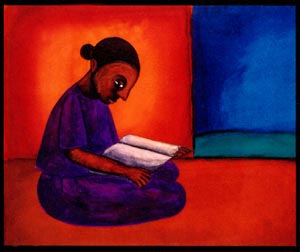 Tell us something about the films that you made?
Tell us something about the films that you made?
All the funding that I got to make my films came from the UK, mostly from channel 4. I then established my studio here. I also did a commercial for bodyshop. While at RCA I wrote a thesis on ‘Indigenous images and narratives for socially relevant animation’. Writing the thesis was tough and I made 2 films to support my thesis.
The first film was called The Harvest. It was based on Warli painting. I went to where these paintings are done. I interacted with the painters and it was amazing to see how contemprary the stories that these artists tell through their paintings are. The stories tackle even issues like gender politics.
The second film, Mani’s Dying, was from a 1960’s path breaking marathi novel called Kosala written by Dr Nemade. The novel which is very modern in its narrative moves back and forth in time, breaking linearity.
My film is based on an excerpt from the book.The story is about coming to terms with suffering and death. The take off point for the look of the film was the cave paintings at Ajanta. Ultimatley the movie turned out to be a very personal film and I was very happy to do it, it was made without any pre conceived notions of what animation was supposed to be.
The impact that this 7 minute film had on the western audience was immense. It was very strange for me to look at the audience moved to tears and reacting strongly – people found the palette very unlike what they had ever seen in their films before. They were struck by the vividness of the colors. The film went all across the world to many festivals and was nominated as best british student film. That’s another reason why I feel our work has great potential if we do it our way and do it with conviction.
Yet another interesting thing I did while in the UK, was the residency at MOMI (Museum of the Moving Image). MOMI is a film museum and it organizes competitions for its residency, 4 winners are selected and each one of them is awarded a residency for 3 months. For my residency, I used to sit in the animation booth working on my animation project. Visitors would come and see how the work was being done and get an idea about the animation process. It’s a very brilliant concept and a great initiative on MOMIs part to create awareness about animation and at the same time support the art by funding it. Also as the project takes shape, Channel 4 comes in and if they like your development work they fund your project.
They say film making is very addictive. Now that you are into the IDC course full time do you miss film making?Any projects that you have lined up?
I am currently working on completing a 13 min film called The adventures of goll goll the film is on the rights of the child. This is for the Tata Institute of Social Sciences and should be ready early next year. There are other short animation projects that have been scripted and storyboarded, for these i am looking for funds. Besides my films there is a pet project at our IDC animation department too.
What’s that?
It’s a documentation of Indian Animation.The report charts the Timeline of Indian Animation through the 30’s to the current time, listing more than a hundred animated films and shorts. We are trying to collect all available information on animation in India.
Before Animation was introduced, people enjoyed projected images on the silver screen in India, the most traditional of it being the leather puppet show of Andhra Pradesh. Around 1880, the birth of animation was hinted with ordinary magic lantern shows which had movement added to it by the father and son duo Mahadeo Gopal and Vinayak Mahadeo Patwardhan with Shambarik Kharolika, which progressed in the years to come with pioneers like Dadasaheb Phalke, Ram Mohan, Bhimsain, Satam, Suresh Nayak, G.K.Gokhale, Kantilal Rathod, Pramod Pati, V.G.Samant.
All the organisations and institutions that have contributed to the growth of this medium have been listed along with their activities in animation. The list includes Film production units like The Films Division in Mumbai and the Children’s Film Society.
It also maps the growth of Animation through a series of filmmakers like J.S.Bhownagary (Radha and Krishna), Ezra Mir and G.K.Gokhale (A Great Problem, This Our India, Chaos) and Ram Mohan (Harmony).
Finally it draws an inference that from the initial attempt at Animation in India with basic stop motion to Computer Generated Animation, animation has grow leaps and bounds over the years.
